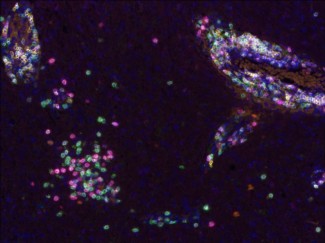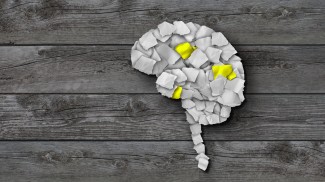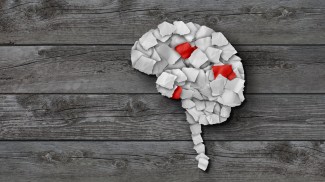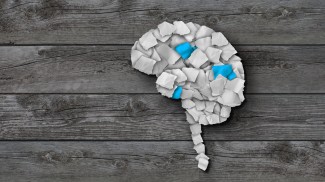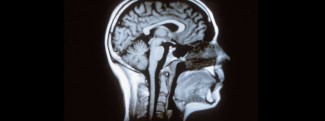A tumour is formed of cells that multiply in an uncontrolled way, taking over the surrounding cells and, to varying degrees, disrupting brain function. A brain tumour can develop in any area of the brain.
-
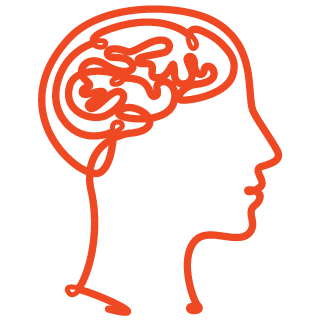
20 % pourcentage que représentent les glioblastomes sur l'ensemble des tumeurs cérébrales
A distinction is made between primary brain tumours, which originate from cells that reside in the brain, and which account for 1% of all cancers, and secondary brain tumours. Secondary brain tumours are much more common and are formed of cancer cells from another organ: the lung, breast, colon, kidney or skin (melanoma), and make up
metastases (the processes by which cancerous cells spread in the body to reach and multiply in organs, beyond the organ initially affected).
There are more than 100 different types of primary brain tumours. The most common are those that develop from the glial cells, or from their precursors, known as gliomas, which include astrocytomas, oligodendrogliomas and glioblastomas. Gliomas rarely cause metastasis in other organs.
Meningiomas, which develop in the meninges between the skull and the brain, are common tumours but are generally not cancerous.
Les tumeurs cérébrales peuvent être classées selon plusieurs critères, notamment leur nature (bénigne ou maligne), leur origine (primaire ou secondaire) et leur type cellulaire :
Tumeurs des cellules gliales (gliomes) :
Les gliomes sont les tumeurs les plus fréquentes et entraînent rarement des métastases dans d’autres organes.
- Astrocytomes : Issus des astrocytes, ils sont classés en plusieurs grades, de grade I (pilocytique, bénin) à IV (glioblastome, très agressif).
- Oligodendrogliomes : Issus des oligodendrocytes, croissance plus lente, meilleur pronostic.
- Épendymomes : Développés à partir des cellules de l’épendyme, souvent situés près des ventricules cérébraux.
Tumeurs des méninges
- Méningiomes : tumeurs bénignes dans la majorité des cas, elles peuvent néanmoins comprimer le cerveau selon leur localisation.
Tumeurs embryonnaires
- Médulloblastomes : tumeurs très agressives, elles affectent surtout la fosse cérébrale postérieure.
Tumeurs hypophysaires
- Adénomes hypophysaires : tumeurs bénignes, elles peuvent entraîner des troubles hormonaux.
Lymphomes cérébraux primitifs
- Issus des cellules immunitaires dans le cerveau, ce type de tumeurs est souvent associé à une immunodépression.
The causes of brain tumours
Brain tumours are not usually hereditary; however, in some cases genetic markers have been identified that very slightly increase the risk of developing this type of cancer in a particular individual.
Cancer tends to be linked to successive mutations in a given cell, and in specific genes responsible for the proliferation of the tumour-forming cells. These mutations are only present in the cancer cells, and not in the body as a whole. They are not, therefore, hereditary.



Brain tumour symptoms and diagnosis
The symptoms of a brain tumour depend on the type of tumour, its location in the brain, its size and its speed of development.
Symptoms that may indicate a brain tumour vary and will depend on the location of the tumour inside the brain and how fast it grows.
A brain tumour can also be discovered after an epileptic seizure. This is the most common way that slow-growing tumours are discovered.


Treatments for brain tumours
As with other cancers, the majority of treatments for brain tumours require surgery, radiotherapy and chemotherapy, depending on each individual case.
Treatment for primary brain tumours, especially gliomas, is difficult for several reasons:
- Their location, which makes options for surgery limited, or even impossible;
- The blood-brain barrier, which isolates and protects the brain from pathogens but also hinders the penetration of anti-cancer drugs;
- The intrinsic resistance of many tumours to radiotherapy and chemotherapy;
- The fragility of brain tissue at high doses of radiotherapy.
However, current research, in terms of basic research to understand the biological mechanisms of tumours, as well as clinical research, should lead to new targeted and personalised therapeutic approaches. Targeted innovative therapies have already proven effective in highly specific sub-groups.

Support Paris Brain Institute
Did you like this content and did it answer the questions you were asking? Don't hesitate to support Paris Brain Institute.

